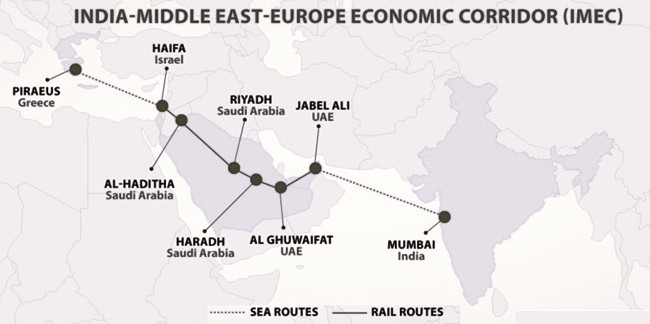Apr 26, 2025
Apr 26, 2025
... It could Redefine Global Trade Power
The India-Middle East-Europe Economic Corridor (IMEC) may not just rival China’s Belt and Road Initiative — it could reshape the very DNA of international commerce, connectivity, and cooperation.

Is the future of global trade shifting westward from China’s Belt and Road to a new India-led corridor? Could this be the beginning of a multipolar trade world, where India, Europe, and the Middle East together rewrite the logistics map of the 21st century? More importantly, what will it mean for energy security, digital infrastructure, and the emerging battle of influence between East and West?
The India-Middle East-Europe Economic Corridor (IMEC) is not just a trade route — it is a geopolitical statement, a logistical masterstroke, and an economic game-changer. Launched at the G20 Summit in New Delhi in September 2023, the initiative is backed by India, the European Union, the United States, the UAE, Saudi Arabia, and Israel, among others. It seeks to forge a seamless trade path linking Mumbai to ports in the UAE, crossing Saudi Arabia and Jordan, proceeding into Israel, and culminating in European ports via Greece and Italy.
This East-to-West bridge is designed to reduce shipping time by 40%, optimize cargo costs, and offer a clean, secure alternative to China's Belt and Road Initiative (BRI) — which, despite its massive reach, has drawn criticism for fostering debt dependency and lacking transparency.
A Corridor of Global Consequence
Unlike the BRI, which is rooted in China’s centralized control and infrastructure diplomacy, IMEC is collaborative, democratic, and diversified in participation. It offers a multilateral response to an increasingly fragmented world economy.
Key highlights of IMEC’s transformative potential include:
Strategic Connectivity: Linking Indian ports to the Arabian Peninsula and European logistics hubs, IMEC offers a clear geostrategic advantage by avoiding volatile chokepoints like the Bab-el-Mandeb Strait and the Suez Canal bottleneck.
Sustainable Infrastructure: IMEC will integrate green energy corridors, hydrogen transport systems, and fiber-optic cables, making it an environmentally sustainable and digitally intelligent trade highway.
Technology & Innovation Focus: With nations such as India and Israel at the forefront of digital transformation and innovation, the corridor is set to evolve into a hub of smart ports, AI-enabled logistics, and clean energy transit.
The Strategic Chessboard: IMEC Vs. BRI
The BRI, launched by China in 2013, has invested over $1 trillion in 147 countries through railways, ports, and highways. While this has expanded Chinese influence across Asia, Africa, and Latin America, it has also drawn fire for lack of debt transparency. For instance, Sri Lanka had to lease its Hambantota Port to a Chinese company for 99 years due to unsustainable debt, sparking global concern.
IMEC, by contrast, is not a debt trap but a trust corridor. Its multilateral structure fosters shared decision-making, financial transparency, and resilience, which are key demands from the Global South. Unlike China’s state-led model, IMEC is private-sector friendly, attracting capital from global players like Maersk, DP World, and MSC.
Economic Ripple Effects
According to projections from global think tanks, IMEC could add up to $1.2 trillion in trade value by 2030. Some of the anticipated benefits include:
Boost to Indian Exports: Reducing transportation time will enhance India’s competitiveness in sectors such as textiles, pharmaceuticals, and electronics.
Middle East Diversification: For Gulf countries such as the UAE and Saudi Arabia, IMEC complements their Vision 2030 plans to reduce dependency on oil and become logistic hubs.
European Supply Chain Stability: Europe’s over-reliance on China for supply chains was exposed during COVID-19. IMEC offers an alternative that is faster, safer, and politically neutral.
Challenges on The Horizon
While IMEC’s promise is enormous, execution will require coordinated diplomacy, infrastructure synchronization, and security assurances, especially in politically sensitive regions like the Middle East.
Turkey, notably bypassed in the IMEC route, has raised concerns, seeing the corridor as a rival to its own Middle Corridor initiative that connects China to Europe via Central Asia and Turkey. Additionally, the Gaza conflict and regional instability could complicate on-ground implementations.
The U.S.'s firm backing of IMEC also makes it part of the larger geo-economic battle against China’s influence. Yet, its success will depend not just on countering BRI but delivering a model of inclusive and ethical growth.
Not Just a Route — A Vision
The India-Middle East-Europe Economic Corridor is not just about goods crossing borders — it’s about values crossing continents. In an era of fractured globalization, IMEC offers a blueprint for resilient supply chains, green commerce, and shared prosperity.
If built and executed with vision, it could become the artery of the 21st-century economy — a corridor of trust in a world of uncertainty.
But the question remains: will this vision withstand the test of geopolitics, or will it be another well-laid plan lost in diplomatic turbulence? Can IMEC truly dethrone the BRI and set a new standard for global cooperation, sustainability, and prosperity? Only time will tell!
19-Apr-2025
More by : P. Mohan Chandran